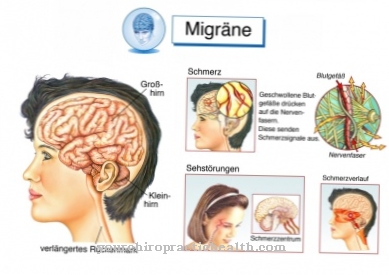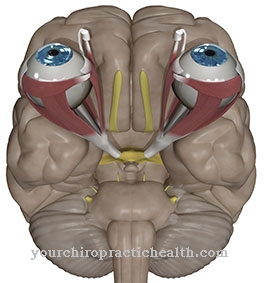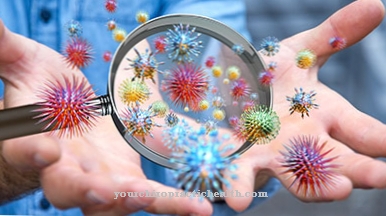Everyone knows that he pulls his hair or wraps it around his finger. Women also like to pluck out annoying facial hair. This is usually not uncommon, but there are also people who compulsively pull their hair out daily and sometimes even for hours until the head has bald spots or even bleeds. This is called Trichotillomania designated.
What characterizes trichotillomania?

© Aj_stock_photos - stock.adobe.com
The word Trichotillomania is made up of the following three Greek terms: "tricho" means hair, "tillo" plucking and "mania" stands for instinctive or even addictive behavior. Trichotillomania, the mental illness, is therefore a compulsive plucking of hair, for example the hair on the head, but also the eyelashes or eyebrows. However, all other hairs such as the beard or pubic hair can also be preferred areas.
This disease, which usually occurs in childhood, is one of the complex impulse control disorders and can last for a few months or even years. The disease is characterized by the fact that the person concerned cannot resist the urge, impulse or temptation to carry out this action.
causes
The exact causes of trichotillomania have not yet been clearly clarified. The triggers must therefore be determined individually for those affected. It is believed that a hereditary disposition associated with certain triggers in the brain leads to neurotransmitter imbalances that trigger the compulsive act.
Other reasons are believed to include traumatic events, such as the death of a close relative, family problems, divorce, abuse, stress, stressful childhood events, or events that reduce self-esteem. According to studies, more than two thirds of those affected have had at least one traumatic experience in their life.
In some cases, a post-traumatic stress disorder was made as a diagnosis. Recognizing your own triggers can be helpful in finding ways and means of dealing with these difficult situations.
Symptoms, ailments & signs
Trichotillomania is primarily noticeable through the compulsive pulling out of the scalp hair. In some cases hair is pulled out from other parts of the body. This causes bald spots to form on the affected areas of the body. Those affected usually do not feel any pain or they are simply ignored.
The actions are often not even consciously experienced, although the urge to pull out the hair is usually felt strongly. Trichotillomania can basically occur at any age. However, it often sets in during puberty.
Diagnosis & course of disease
The disease is easy to spot by the bald spots that appear after tearing it out. Usually the mental illness only lasts for a few months. In some cases, however, it also takes several years. This disorder is almost always accompanied by an inner restlessness, pressure or a feeling of tension. The process of pulling out the hair usually leads to the desired relaxation in the short term.
However, the feelings of anger, shame and fear that often follow increase the inner tension again, which leads to the compulsive impulse again. A vicious circle arises that is difficult to break. The experience of not being able to control oneself leads to feelings of frustration and inferiority. In some cases, therefore, there are comorbidities, such as anxiety disorders or depression. Many people do not want the obsessions to be discovered. As a result, there is social isolation in some cases.
Complications
Since trichotillomania is a purely mental disorder, the disease leads to a number of different mental and physical complaints. In most cases, those affected pull their own hair out. Hair is torn out from different parts of the body, whereby those affected usually do not feel any pain or other unpleasant feelings when tearing it out.
Trichotillomania occurs predominantly during puberty. Many of those affected are therefore bullied or teased, which can only make the symptoms worse.Due to the torn hair, the patients often no longer feel beautiful and therefore suffer from inferiority complexes or from reduced self-confidence.
Furthermore, thoughts of suicide can develop. Patients with trichotillomania also suffer from anxiety disorders or from severe depression. As a rule, social contacts cannot be maintained with the disease. Treatment of trichotillomania is always carried out by a psychologist.
In serious cases, the treatment can also take place in a closed clinic. There are no particular complications. However, the treatment can take a long time and does not always have to be successful. The life expectancy of the person affected is not influenced by trichotillomania.
When should you go to the doctor?
With trichotillomania, the person affected is always dependent on a visit to a doctor. This disease cannot heal itself and the symptoms worsen if treatment is not initiated. Therefore, with trichotillomania, a doctor should be contacted as soon as the first complaints and symptoms appear. An early diagnosis and subsequent treatment can limit further complications. A doctor should be consulted if the person affected compulsively tears his hair off his head.
These complaints can occur especially in stressful or stressful situations and have a negative effect on the quality of life of the person concerned. In most cases, those affected with trichotillomania do not even notice the tearing out themselves, so that outsiders should point out the symptoms to the patient.
A psychologist should be consulted with trichotillomania. In many cases, friends or family will have to persuade the person to seek treatment. The further course cannot be generally predicted. However, the life expectancy of the person affected is not reduced or otherwise restricted by this disease.
Treatment & Therapy
Trichotillomania can be treated. Psychotherapeutic treatment plays an important role, especially if the course is severe. Behavioral therapy supports those affected in recognizing the behaviors and symptoms and, above all, the triggers and then changing their behavior. During the therapy, the person affected should learn to gradually cope with the disease and its consequences.
However, this takes time until the well-established patterns of action are discarded and replaced by new ones. Supplementary drug therapy can also help suppress the compulsive impulse and counteract the side effects such as depression or anxiety, which often occur on the side. Many patients respond positively to antidepressants. Only the use of medication is not recommended, because when these are discontinued, the urge to pull out the hair often arises again. It is therefore advisable to use behavior therapy at the same time.
Relaxation techniques such as autogenic training or progressive muscle relaxation are recommended to reduce stress. Support from caregivers is also helpful. Which measures are successful for the person concerned must always be decided individually. Medical treatment is not always required. A favorable prognosis can be made even in difficult cases.
You can find your medication here
➔ Medicines to calm down and strengthen nervesprevention
As a preventive measure, it has been found helpful to make a plan to keep yourself from compulsive urges. This means, when the desire to pull out the hair is noticed, that the urge is replaced by positive thoughts or relaxation opportunities are used in these moments.
It is advisable to take a few minutes for yourself in these situations in order to clear your head. The stress should be reduced. However, this does not only apply in these situations, it is fundamentally important to switch off all stress triggers as far as possible in order to create a psychological balance.
Aftercare
In most cases, those affected have only limited follow-up measures available for trichotillomania, as it is a rare disease. If the disease has been present since birth, it usually cannot be completely cured. Therefore, if those concerned want to have children, they should undergo genetic testing and counseling in order to prevent the disease from being passed on to their offspring.
There can be no independent healing. Most patients depend on the use of different medications and also on the use of different ointments and creams. The doctor's instructions should always be followed, with regular intake and use as well as the prescribed dosage.
If anything is unclear or there are severe side effects, those affected with trichotillomania should consult a doctor. In the case of trichotillomania, contact with other patients with the disease can also be very useful, as this leads to an exchange of information on how to cope with everyday life more easily. This disease may lead to a reduced life expectancy for the person affected.
You can do that yourself
If trichotillomania is found, self-help measures should only take place as an accompanying measure. Since the treatment proves to be comparatively difficult and there are still no universally valid therapies, all measures should be coordinated. Only in this way can the problem be fully resolved.
In many cases, inner turmoil and restlessness trigger the pulling out of the hair. Relaxation techniques such as autogenic training can eliminate the cause of the hair plucking impulse. In addition, the reaction of the environment plays an important role. Parents and relatives should definitely avoid allegations. Otherwise the problem will intensify. Children accumulate aggression and have no place to retreat. Rather, successes, i.e. the failure to pluck, should be adequately appreciated and rewarded.
Since the head is the subject of the sick child and its environment anyway, it should be viewed positively. Head massages provide pleasant stimuli. The use of hair accessories, hats and scarves promises a creative approach to the disease. Trichotillomania is an issue especially when it comes to hairdressing appointments. Parents should inform them about the disease in advance. Sometimes there are ways of making the torn out areas invisible through certain hairstyles.

.jpg)


-durch-folsuremangel.jpg)












.jpg)







.jpg)


